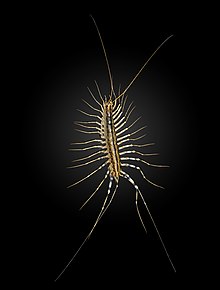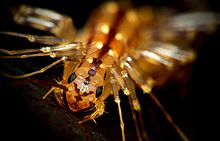Scutigera coleoptrata
| House centipede | |
|---|---|

| |
| Scientific classification | |
| Domain: | Eukaryota |
| Kingdom: | Animalia |
| Phylum: | Arthropoda |
| Subphylum: | Myriapoda |
| Class: | Chilopoda |
| Order: | Scutigeromorpha |
| Family: | Scutigeridae |
| Genus: | Scutigera |
| Species: | S. coleoptrata
|
| Binomial name | |
| Scutigera coleoptrata | |
Scutigera coleoptrata, also known as the house centipede, is a species of
Etymology
In 1758, Carl Linnaeus described the species in the tenth edition of his Systema Naturae, giving the name Scolopendra coleoptrata, writing that it has a "coleopterated thorax" (similar to a coleopter).[3] In 1801, Jean-Baptiste Lamarck separated scutigera from scolopendra, calling this species Scutigera coleoptrata.[4] The word scutigera comes from Latin gerere 'to bear' and scutum 'shield', because of the shape of the plates in the back of the chilopod.[5]
Morphology
The body of an adult Scutigera coleoptrata is typically 25 to 35 mm (1.0 to 1.4 in) in length, although larger specimens are sometimes encountered.
Unlike most other centipedes, house centipedes and their close relatives have well-developed
Reproduction and development
House centipedes lay their eggs in spring. In a laboratory observation of 24 house centipedes, an average of 63 and a maximum of 151 eggs were laid. As with many other arthropods, the larvae look like miniature versions of the adult, albeit with fewer legs. Young centipedes have four pairs of legs when they are hatched. They gain a new pair with the first molting, and two pairs with each of their five subsequent moltings. Adults with 15 pairs of legs retain that number through three more molting stages (sequence 4-5-7-9-11-13-15-15-15-15 pairs).[7]
House centipedes live anywhere from three to seven years, depending on the environment. They can start breeding in their third year. To begin mating, the male and female circle around each other. They initiate contact with their
Behavior and ecology



House centipedes feed on
In a feeding study, S. coleoptrata showed the ability to distinguish between possible prey, avoiding dangerous insects. They also adapted their feeding pattern to the type of hazard the prey might pose to them. For wasps, they retreat after applying the venom to give it time to take effect.[8] When the centipede is in danger of becoming prey itself, it can detach any legs that have become trapped. House centipedes have been observed to groom their legs by curling around and grooming them with their forcipules.
In 1902,
It may often be seen darting across floors with very great speed, occasionally stopping suddenly and remaining absolutely motionless, presently to resume its rapid movements, often darting directly at inmates of the house, particularly women, evidently with a desire to conceal itself beneath their dresses, and thus creating much consternation.
Habitat
Outdoors, house centipedes prefer to live in cool, damp places. Centipede respiratory systems do not provide any mechanism for shutting the spiracles, and that is why they need an environment that protects them from dehydration and excessive cold. Most live outside, primarily under large rocks, piles of wood or leaves, in barkdust and especially in compost piles. They often emerge from hiding during the watering of gardens or flowerbeds. These centipedes can be found in almost any part of the house, although they are usually encountered in dark or dimly lit areas such as basements and garages. Inside the home, they can be found in bathrooms and lavatories, which tend to be humid, but they can also be found in drier places like offices, bedrooms and dining rooms. They are usually seen crawling along the ground or floor, but they are capable of climbing walls. The greatest likelihood of encountering them is in spring, when they emerge due to warmer weather and in autumn/fall, when the cooling weather forces them to seek shelter in human habitats.
Distribution
S. coleoptrata is
Biological details
The faceted eyes of S. coleoptrata are sensitive to daylight and very sensitive to
Some of the plates covering the body segments fused and became smaller during the evolution to the current state of S. coleoptrata. The resulting mismatch between body segments and
| Tergite | 1 | 2 | 3 | 4 | 5 | 6 | 7 | 8 | 9 | 10 | 11 |
|---|---|---|---|---|---|---|---|---|---|---|---|
| Segments | 1 | 2 | 3, 4 | 5, 6 | 7, 8, 9 | 10, 11 | 12, 13 | 14, 15 | 16 | 17 | 18 (telson) |
| Leg pairs | Forcipules | 1 | 2, 3 | 4, 5 | 6, 7, 8 | 9, 10 | 11, 12 | 13, 14 | 15 (antenna-like snare legs) | (gonopod) | (anus) |
Tergites 10 and 11 are not fully developed and segment 18 does not have a
Another feature that sets S. coleoptrata apart from other centipedes is that their hemolymph was found to contain proteins for transporting oxygen.
The
Interaction with humans
Unlike its shorter-legged but larger tropical cousins, S. coleoptrata can live its entire life inside a building, usually on the ground levels of homes. Many homeowners may be unsettled by house centipedes due to their speed and appearance. However, they pose little to no threat towards humans, and are often beneficial as they catch other, more harmful pests, such as cockroaches.[14] They are not aggressive and usually flee when disturbed or revealed from cover. Sting attempts are therefore rare unless the centipede is cornered or aggressively handled. Its small forcipules have difficulty penetrating skin, and even successful stings produce only mild, localized pain and swelling, similar to a bee sting. Allergic reactions to centipede stings have been reported, but these are rare; most stings heal quickly and without complication.[6][15]
References
- ^ a b Steve Jacobs (2009). House Centipede (PDF). Pennsylvania State University. Archived from the original (PDF) on 17 May 2020.
- ^ Ricks, Winston. "Scutigera Coleoptrata". Animal Diversity. Regents of the University of Michigan. Retrieved 28 March 2015.
- ^ Linné, Carl von; Salvius, Lars (1758). Caroli Linnaei...Systema naturae per regna tria naturae :secundum classes, ordines, genera, species, cum characteribus, differentiis, synonymis, locis. Vol. v.1. Holmiae: Impensis Direct. Laurentii Salvii.
- ^ Lamarck, Jean-Baptiste (1801). Systême des animaux sans vertèbres; ou, Tableau général des classes, des classes, des orres et des genres de ces animaux. Paris: L'Auteur.
- ^ "Scutigera - Wiktionary". en.wiktionary.org. 4 June 2018. Retrieved 2020-09-23.
- ^ a b c Steve Jacobs (March 13, 2017). "House Centipedes". Extension. Pennsylvania State University. Retrieved 2021-06-08.
- ISBN 978-0-931876-19-6. Archived from the originalon 2017-07-08. Retrieved 2009-02-09.
- ^ a b c Lewis (2007), pp. 185–186.
- ^ "Species Scutigera coleoptrata Linnaeus, 1758". Australian Faunal Directory. Dept of Climate Change, Energy, the Environment and Water, Australia. 2010. Retrieved 15 March 2023.
- .
- ^ Lewis (2007), p. 120.
- ^ Richard Fox (June 28, 2006). "Scutigera coleoptrata". Lander University. Archived from the original on September 1, 2006. Retrieved April 1, 2010.
- PMID 14963096.
- ISBN 978-0-618-15310-7. Retrieved July 3, 2009.
- ^ Jeffrey K. Barnes (May 22, 2003). "House centipede". Arthropod Museum. University of Arkansas. Archived from the original on 2017-06-01.
Bibliography
- J. G. E. Lewis (2007). The Biology of Centipedes. ISBN 978-0-521-23413-9.
External links
- House Centipede Fact Sheet
- R. Wicks (2001). "Scutigera coleoptrata". Animal Diversity Web. University of Michigan.
